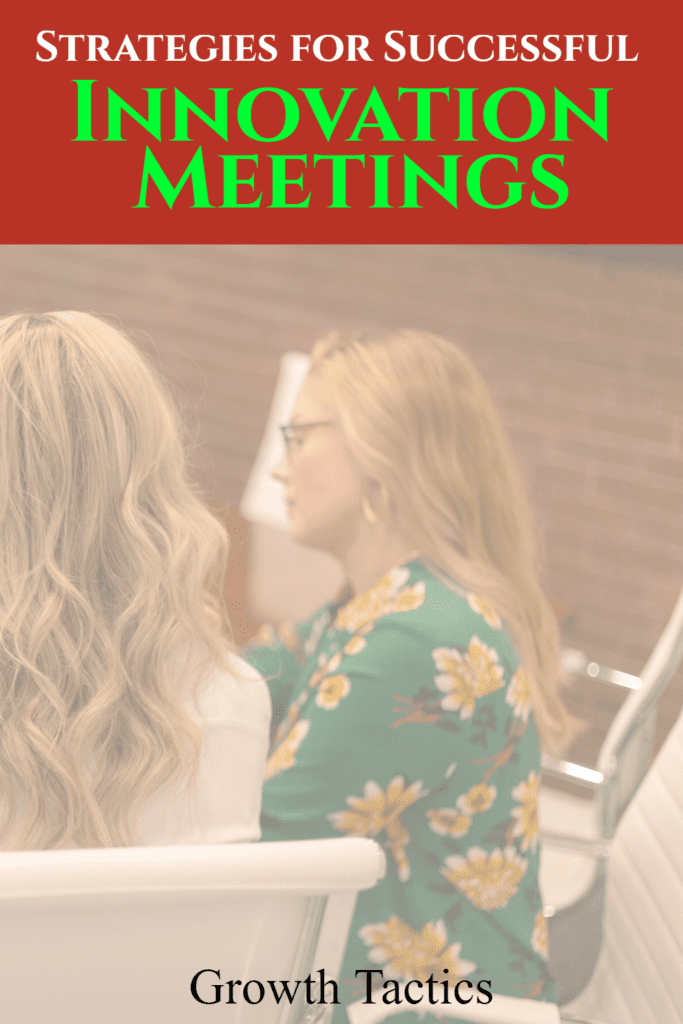Successful innovation meetings drive the development of new ideas and foster a collaborative environment. By bringing together diverse team members, these meetings aim to generate innovative solutions. In this article, we will explore strategies for effective innovation meetings, including meeting formats, brainstorming techniques, idea evaluation, and collaboration. These strategies will help organizations unlock their full innovative potential.
Jump To Section
Defining the Purpose and Objectives
Before diving into the strategies for successful innovation meetings, it is essential to establish a clear understanding of their purpose and objectives. Innovation meetings serve as a platform to generate new and innovative ideas, address challenges, or seize opportunities. They provide an opportunity for team members with diverse backgrounds and expertise to contribute their unique perspectives.
The primary objective of an innovation meeting is to foster creativity and collaborative thinking. By involving team members from various departments or disciplines, organizations can benefit from a broader range of insights and ideas. This diversity of thought helps to break away from conventional thinking patterns, sparking innovative solutions that can drive growth and competitiveness.
In addition to generating innovative ideas, innovation meetings also play a crucial role in the overall innovation process. They serve as a catalyst for innovation, acting as the starting point where ideas are born and refined. These meetings pave the way for further exploration, evaluation, and implementation of the most promising concepts.
By clarifying the purpose and objectives of innovation meetings, organizations can ensure that all participants are aligned and motivated towards achieving the intended outcomes. This clarity provides a solid foundation for the strategies that will be discussed in the following sections, enabling organizations to maximize the value derived from their innovation meetings.
Preparing for the Meeting
Effective preparation is key to ensuring the success of innovation meetings. Proper planning and organization set the stage for productive and focused discussions. Here are some steps to consider before the meeting:
Define the meeting format: Determine the structure and format that best suits the objectives of the meeting. This could be a traditional meeting format, a workshop-style session, or even a more informal setting depending on the team dynamics and the desired level of creativity.
Set clear objectives: Clearly outline the specific goals and outcomes that should be achieved during the meeting. This helps to keep the team focused and ensures that everyone is working towards a common purpose.
Identify the facilitator: Assign a skilled facilitator who can guide the meeting effectively. The facilitator’s role is to ensure equal participation, manage time, and encourage open communication. This person should be neutral and adept at managing group dynamics to foster a collaborative atmosphere.
Gather relevant materials and resources: Compile any necessary materials or resources that will support the meeting discussions. This may include background information, market research, or other relevant data that can help inspire and inform the generation of innovative ideas.
Communicate and engage with stakeholders: Identify key stakeholders who should be involved in the meeting. Engage them beforehand to gather their input and insights, ensuring that their perspectives are considered during the discussions. This involvement enhances stakeholder buy-in and creates a sense of ownership in the innovation process.
By investing time and effort in preparing for the innovation meeting, organizations can set a solid foundation for success. Clear objectives, an appropriate meeting format, and engaging stakeholders help create an environment conducive to generating and nurturing innovative ideas.
Facilitating Productive Discussions
During the innovation meeting, effective facilitation plays a crucial role in ensuring that discussions are productive and that innovative ideas are generated. Here are some strategies to facilitate a successful innovation meeting:
Encourage equal participation: As the facilitator, create an inclusive environment where everyone feels comfortable sharing their ideas. Encourage active participation from all team members, ensuring that everyone has an opportunity to contribute their perspectives and insights. Acknowledge and value each idea to foster a positive atmosphere that fosters creativity.
Use effective brainstorming techniques: Brainstorming is an essential technique for generating innovative ideas. Encourage participants to think freely and creatively without any judgment. Use techniques like mind mapping, round-robin brainstorming, or the 6-3-5 method to stimulate idea generation. These techniques help to expand thinking and encourage the exploration of diverse possibilities.
Foster collaboration and teamwork: Innovation is often a team effort. Encourage collaboration and teamwork by facilitating group discussions and activities. Create opportunities for team members to build upon each other’s ideas, further developing and refining concepts. Promote active listening and constructive feedback, ensuring that every team member feels heard and valued.
Manage time effectively: Time management is crucial during a meeting to ensure that all agenda items are covered and discussions stay on track. Set a realistic timeline for each agenda item, allowing sufficient time for idea generation, discussion, and decision-making. Use timekeeping techniques, such as setting timers or using a visual countdown, to remind participants of the time remaining for each activity.
Capture and document ideas: During the meeting, capture and document all the ideas generated. Use visual tools like whiteboards or digital collaboration platforms to record ideas so that they are visible to all participants. This helps prevent idea loss and allows for easy reference and evaluation later on.
By employing these facilitation strategies, the innovation meeting can be a space where productive discussions take place, resulting in the generation of innovative ideas. Effective facilitation ensures that all team members are engaged, encourages collaboration, and enables the exploration of diverse perspectives and possibilities.
Evaluating and Selecting Ideas
Once the brainstorming and discussion phase of the innovation meeting is complete, it is important to evaluate and select the most promising ideas. Evaluating ideas helps determine their feasibility, potential impact, and alignment with the organization’s goals. Here are some steps to help in this process:
Establish evaluation criteria: Define the criteria that will be used to assess and compare the ideas. This may include factors such as feasibility, market potential, alignment with organizational strategy, impact, and resource requirements. Clear criteria provide a structured approach to evaluating and comparing ideas objectively.
Encourage open and constructive feedback: Allow participants to provide feedback on each idea, highlighting its strengths, weaknesses, and potential improvements. Foster a culture of open and constructive feedback, where participants feel comfortable sharing their perspectives. Encourage dialogue and discussion to further refine and shape the ideas.
Prioritize and rank ideas: Based on the evaluation criteria, prioritize and rank the ideas. This can be done through a voting process, rating system, or any other method that allows for a systematic comparison of the ideas. Consider the input from all participants to ensure a fair evaluation.
Consider feasibility and resource requirements: Evaluate the feasibility of the ideas by considering the resources, time, and expertise needed for implementation. Identify potential challenges or barriers that may arise and assess the organization’s capacity to overcome them. This evaluation helps identify ideas that are practical and achievable given the available resources.
Select the most promising ideas: Based on the evaluation and prioritization, select the most promising ideas that align with the organization’s goals and have the highest potential for success. Consider the overall impact, feasibility, and strategic fit of each idea in making the final selection. Communicate the chosen ideas to the team and acknowledge the contributions of all participants.
Develop action plans: Once the ideas are selected, develop action plans to move them forward. Assign responsibilities, set timelines, and define the necessary steps for implementation. By creating clear and actionable plans, the organization can effectively execute the chosen ideas and bring them to fruition.
By following a systematic evaluation process, organizations can identify and select the most promising ideas generated during the innovation meeting. This ensures that resources are focused on ideas with the highest potential impact and enhances the chances of successful implementation.
Implementing and Reviewing the Chosen Ideas
Once the most promising ideas have been selected during the innovation meeting, it is time to move forward with their implementation. Successful implementation requires careful planning, effective execution, and regular review. Here are some steps to consider during the implementation and review phase:
Develop a detailed implementation plan: Create a comprehensive plan that outlines the necessary steps, resources, and timelines for implementing the chosen ideas. This plan should address potential challenges, allocate responsibilities, and set clear goals and milestones. Be sure to communicate the plan to all relevant stakeholders to ensure alignment and understanding.
Assign dedicated project teams: Establish dedicated project teams or assign specific individuals to oversee the implementation of each chosen idea. These teams should have the necessary skills and expertise to drive the ideas forward. Regularly communicate with the teams to provide guidance, support, and feedback, ensuring that progress is on track.
Monitor and track progress: Regularly monitor the progress of each idea’s implementation. Track key metrics and milestones to measure progress against the established goals. This monitoring provides insights into the effectiveness of the implementation and allows for timely adjustments and interventions if needed.
Foster a culture of innovation: Encourage a culture of innovation within the organization by recognizing and rewarding innovative efforts and outcomes. Celebrate small wins and milestones along the way to maintain motivation and engagement. This positive reinforcement reinforces the importance of innovation and encourages ongoing creativity and idea generation.
Review and evaluate outcomes: Conduct regular reviews to evaluate the outcomes and impact of the implemented ideas. Assess whether the expected benefits and objectives have been achieved and gather feedback from stakeholders. Use this information to make informed decisions about scaling, enhancing, or modifying the ideas for even greater success.
Learn from failures and successes: Embrace the concept of “failing fast” and view failures as learning opportunities. Encourage a growth mindset within the organization, recognizing that experimentation and innovation inherently involve risks. Learn from both the successes and failures to continually improve the innovation process.
By diligently implementing the chosen ideas and conducting regular reviews, organizations can maximize the chances of successful outcomes. This iterative process of implementation, evaluation, and learning helps refine innovation efforts and drive ongoing improvement in the organization’s ability to generate and implement innovative ideas.
Conclusion
Innovation meetings are crucial for organizations seeking to generate and implement innovative ideas. By fostering collaboration, encouraging feedback, and employing a structured approach, these meetings can spark creativity and ensure the selection of the most promising ideas.
Through careful planning, monitoring progress, and reviewing outcomes, organizations can drive successful implementation and continuous improvement. Embracing innovation meetings is key for organizations aiming to thrive in today’s fast-paced business landscape.


